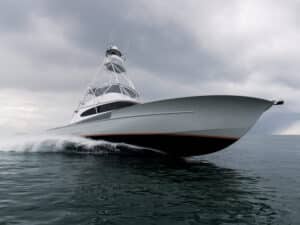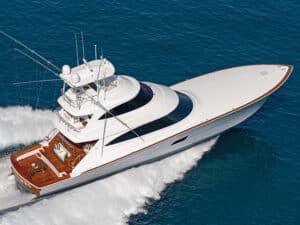
Viking52C
After running along in a following sea, I lazily spun the wheel and put the bow of the new Viking 52C into the long, deep and low ocean swell. The early morning sun, now red and leaning toward orange, cast a shimmering path out to the horizon. The gaudy and colorful skyline of Atlantic City, New Jersey, back-dropped by fair-weather clouds in a blue sky, began to shrink behind me as I headed offshore. I took a glance at the well-positioned — and quite beautiful — Release Marine teak center-console helm station, taking particular note, as is my habit when running any boat, of the engine and systems parameters, including revolutions per minute, rate of speed and gallons per hour. All was in order, and the instruments told the rest of the story: 1,750 rpm, 31.5 knots, 76 gph.
It was also, as I remarked to my four companions up on the flybridge, quite comfortable in those relentless mostly four-foot rollers. And while there would be many more outstanding observations to make by the time I got the new Viking 52C back to the dock, the real story about the latest convertible from the venerated New Jersey builder begins back at Viking Yachts’ 810,000-square-foot Bass River plant, way before the fully infused 52 hulls and all their myriad parts move down the production line and ultimately to the water and their new owners.
Design and Engineering
“When we sit down at what I like to refer to as the ‘group lunch meetings,’ ” Viking designer Dave Wilson says, “it includes sales, marketing, our executives and even our demo captains and mates as well. And while we’ll discuss everything about a new design — whether it be on a 42- or 92-footer — and anything from the running bottom, to the interior, to the flying bridge, in the end, we’re not going to do something unless it’s a positive improvement.”
Some remarkable products have come out of those meetings, and that last statement Wilson mentioned is as important to Viking as any other concept in the company’s long and storied history, which dates back to 1964.
Joe Snodgrass, the company’s naval architect, gave some insight as well. “Among the many other factors that we paid attention to, there were two main focus points in the 52C’s design and engineering of particular importance,” Snodgrass says. “One was the actual shape of the hull, where it is wide or narrow, its chine distribution and the ability to efficiently move it through the water along with everything that goes inside. The second was keeping things properly balanced so that the performance is right where it is supposed to be. That was the ultimate goal.”
To accomplish that goal, the Viking design and production team looked at what they had learned when building the 52’s larger siblings — especially the 62EB and 54C. Both Wilson and Snodgrass agreed that the 52C is an almost identical sister ship to the 62EB. “Everything we learned from the bigger boat, all the significant positive changes that made her such a successful build, we put into this boat,” Wilson says. Those changes included the removal of the keel, no fair body flat on the bottom, the increase in warping deadrise and the elimination of the offset knuckle fully aft, thus adding more flat bottom at the transom.
The question of balance also came up as the conversation shifted to the deep pockets used on the 52C. “While pocket use results in taking away buoyancy, it nets out with the decrease in draft,” Snodgrass says. Indeed, even with the added weight of the bigger engines and optional fuel tanks, this boat lost some three inches over the previous 52C, one designed without pockets. “Pockets also tolerate less tip clearance for the props, here about 7.5 percent as compared to about 10 to 15 percent on a traditional hull, thus cutting down on impulse and vibration and permitting the use of a flatter shaft angle, larger diameter props and deeper gear ratios,” Snodgrass says. Translation: Better and more-efficient performance.
Construction
Viking’s commitment to making positive improvements found its way into its construction techniques as well. The hull of the 52C is now fully infused, as are many of the boat’s parts, including the fuel tanks and air boxes, among others. Those fuel tanks, along with both the freshwater and holding tanks, all have fiberglass baffles inside. They have balsa-cored sides for added stiffness and are sealed to the hull with resin foam.
For added strength, her hull boasts a Kevlar/carbon-hybrid laminate construction to shed weight without sacrificing muscle. “We will be the last to show up at the dance and not follow in anyone else’s footsteps,” Wilson says. “We will never give up strength for weight.”
The stringers are encapsulated and foam-cored, and the composite bulkheads — main, intermediate engine room and forward — are vacuum-bagged. The salon sole, which is the engine room overhead, is Airex-cored for both sound and thermal insulation. As in the 42C, the entire forepeak area is a one-piece liner.
Performance
Striking just the right balance between construction and performance is what Viking strives to give to its owners — you can’t be the one sitting at the dock when it gets a little snotty come tournament day. Luckily, I got out on the water in something other than flat-calm conditions, and the 52C proved its mettle in more ways than one.
The 52C sports a sharp, fine entry that comes in somewhere between 45 and 47 degrees and was designed to take on varying sea conditions. The running bottom transitions back to an almost 12-degree deadrise at the transom, which produces superior planing characteristics. I was able to get the 52C test boat, equipped with the optional MAN V12 1400 CRMs, to cruise at 36 knots while turning 2,000 rpm and burning 100 gph. We had 800 gallons of fuel aboard — with the optional 1,467-gallon tankage onboard my test boat — and topped-off water at 186 gallons. She answered the helm with authority on turns, pushed through those rollers with all the sureness of her pedigree and landed softly after hitting the occasional errant big one.
Those MANs, by the way, were virtually smokeless upon start up and while performing precise backing-down maneuvers.
Bridge, Cockpit and Engine Room
At her heart, the 52C is a fishing machine, and to that end, Viking equipped this boat to be a formidable, top-of-the-food-chain predator and high-performing competitor on the tournament circuit, should that be her owner’s wish.
As I performed several backing-down maneuvers, I noted how easily I was able to glance back and forth from the helm into the seaway and then down at the 142-square-foot cockpit, imagining the exciting action taking place on the deck and out on the water.
The flybridge area offers up an amazingly comfortable space with a four-sided enclosure, air conditioning, hardtop, rocket launchers and, of course, a custom Palm Beach Tower, Ruppriggers and electric reels in the overhead. There is bench seating to either side, tons of storage areas, an optional refrigeration cabinet and, in a very nice design touch, a pair of individual bucket seats forward of the helm. On this boat, a vast array of Atlantic Marine Electronics products peppered the helm station.
The cockpit offers every kind of fishing cabinet and storage area one would need; an extended bridge overhang; in-deck fish boxes; optional Eskimo shaved-ice maker and livewell; rod holders galore; molded-in transom fish box; optional Release chair; and a mezzanine seating area with a freezer compartment, full-tackle cabinet, insulated storage box and access to the engine room. The lazarette hatch in the cockpit sole allows exceptional access to steering, trim tabs and drain pumps.
The Awlgrip-covered engine room is a hands-on skipper or owner’s dream. Even with the optional big MANs down here and the 21.5-kW e-QD Cummins Onan engine generator, I found it easy to get two hands on any piece of equipment one would have to work on without worrying about how -— or where — to swing a wrench. All fluid checks are readily available, as is the cabinet for Viking’s centralized sea-water system.
Interior
Inside, the 52C is all Viking as well, and just because she’s a hard-core battlewagon doesn’t mean that there is a cutback on comfort. A choice of rich, finely finished woods and elegant fabrics is available to suit individual needs.
The salon offers wide-open spaces and takes full advantage of the boat’s 17-foot-6-inch beam. The galley sits to starboard and has under-counter refrigerator and freezer compartments along with ample closets and storage cabinets. The dining area is on the port side opposite a sizable couch located to starboard.
Offering a choice of configurations in the bow — crossover berths or custom queen — the three-stateroom, two-head layout gives you and your guests, whether fishing or not, the kind of roominess and use of space associated with Viking’s careful attention to creature comforts.
The new Viking 52C lives up to all expectations and most likely will exceed many of yours when you step aboard. Taking into consideration her excellent sea-keeping abilities and her strong genes passed down the production line by all her predecessors, this purpose-built boat will surely make a strong impression wherever she calls home.
Specifications
LOA: 53′ 2″
BEAM: 17′ 6″
DRAFT: 5′ 0″
DISP: 70,260 pounds
FUEL: 1,202 gallons*
WATER: 186 gallons
ENGINES: Two 1400 CRM V12 MAN
GENERATOR: 21.5-kW e-QD Cummins Onan
VIKING YACHTS
****609-296-6000
****www.vikingyachts.com







